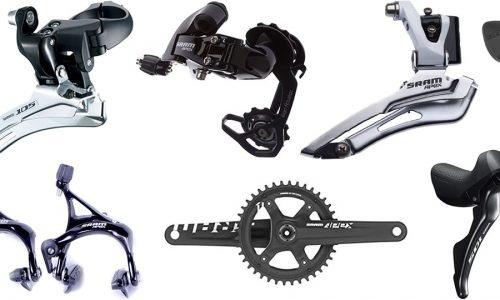Cycling is an amazing sport that comes with a huge amount of benefits. It helps you stay in shape, brings you into new social circles, and even working on a bike can be fun. The beauty of bikes is they come in all shapes and with different parts.
A question we are commonly asked is about bottom brackets. A bottom bracket is a vital part of the bike. Like any mechanical component does wear out over time.
In this article, we’ll be telling you all about bottom brackets and the different types.
What is a Bottom Bracket?
A bottom bracket is a piece on a bike that sits inside the crank. It allows the pedals to rotate back and forward freely. It uses a set of bearings inside.
They attach to the bike in a few different ways. Typically a bottom bracket can last as little as 3000 miles all the way up to 20000 miles.
The different types of Bottom Bracket
Before we speak about the different bottom bracket types, it’s important to understand we are not going to speak about every single bottom bracket individually. There’s a huge amount of different types you can buy.
If we were to list them all, this would be a very long article that would be outdated quickly. Instead, we have broken them down into types.
Press Fit
The first type we’re going to speak about is press-fit bottom brackets. These are very popular on all types of bikes, but you will generally see them the most on racing bikes. They are a bottom bracket that sits directly in the frame, making the cranks practically completely flush with the frame itself.
They generally have cartridge bearings, which can either be pressed directly into the frame or into cups that sit in the frame. To install these, you require a press fit tool.
This is where you force the bracket into the frame into an incredibly tight fit, so it doesn’t come loose. They can be challenging to remove sometimes.
Typically press-fit bottom brackets use cartridge bearings. This means they are not serviceable, and you change the bottom bracket to a new one with new bearings. This is a much better system than serviceable bearings like cup and cone, which we will discuss later.
Press Fit Bottom Brackets
The press-fit bottom bracket comes in a huge amount of different sizes, such as BB30, PF30, BB86, BB92, and more. Here are the most common on the market and what makes them special.
BB30
The BB30 has a shell diameter of 42mm and comes in a shell width of 68mm on road and 73mm on MTB with an internal diameter of 30mm.
To be installed it uses a bearing press combined with circlips to install directly into the frame. The BB30 is designed for specific BB30 cranks.
BB30A and BB30-83
The BB30A and BB30-83 are owned by Cannondale and are for their bikes. It has a shell diameter of 42mm and a shell width of 73mm on the BB30A and 83mm on the BB30-83, hence the 83mm.
It has an internal diameter of 30mm. It’s pressed in the frame with the aid of circlips. Compared to the BB30, it’s wider, which offers better bearing support.
BB86 or BB92
The BB86 and BB92 have a shell diameter of 41mm, a shell width of 86.5mm on road, and 91.5 on MTB. The internal diameter is 24mm.
When being installed, it is pressed into cups that sit in the frame, not the frame directly like the BB30. The BB86 and BB92 are designed for cranks with a 24mm spindle, but some are available for 30mm but much less common.
BB90 and BB95
Trek owns the BB90 and BB95. It has a shell diameter of 37mm, a shell width of 90mm on road and 95mm on MTB, and an internal diameter of 24mm.
One thing that makes the BB90 and BB95 different is that the shell is stepped inside. When being installed, it is pressed but works with the same process.
PF30
The PF30 from SRAM has a shell diameter of 46mm and a shell width of 68mm on road and 73mm on MTB. It comes with an internal diameter of 30mm.
It is similar to the BB30 but is designed to be pressed in cups instead. It is made for BB30 cranks and is much better for manufacturing tolerances.
PF30A and PF30-83
The PF30A and PF30-83 have a shell diameter of 46mm and a shell width of 73mm on the PF30A and 83mm on the PF30-83. It comes with an internal diameter of 30mm.
This is Cannondales own creation and is the Press fit cup version of the BB30A and BB30A-83.
OSBB
The OSBB is a bottom bracket designed and owned by Specialized. It has a shell diameter of 42mm and a shell width of 68mm on road and 73mm on MTB. Again this is another bottom bracket designed for BB30 cranks and comes with an internal diameter of 30mm.
The OSBB is press fitted into a bike using cups, making it better for manufacturing tolerances. It’s a Specialized version of the PF30.
BBRight
The BBRight comes in two types, direct and press fit. These are both designed for road only. Direct fit has a shell diameter of 42mm, a shell width of 79mm, and an internal diameter of 30mm.
The direct is pressed into the frame directly. The press fit has a slightly larger shell diameter of 46mm and a shell width of 79mm. The press is installed into cups inside the frame, which makes it different from the direct version.
BB386EVO and BB392EVO
The BB386EVO and BB392EVO both have a shell diameter of 46mm but differ when it comes to shell width. The BB386EVO is 86.5mm, and the BB392EVO is 91.5mm. They both come with an internal diameter of 30mm.
They will work with 386EVO cranks and even traditional external bottom brackets, making them adaptable for many bike groupsets.
| Bottom Bracket | Shell Diameter | Shell Width | Internal Diameter | Installation |
| BB30 | 42mm | 68/73mm | 30mm | Direct |
| BB30A and BB30-83 | 42mm | 73/83mm | 30mm | Direct |
| BB86 or BB92 | 41mm | 86.5/91.5mm | 24mm | Cup |
| BB90 and BB95 | 37mm | 90/95mm | 24mm | Stepped |
| PF30 | 46mm | 68/73mm | 30mm | Cup |
| PF30A and PF30-83 | 46mm | 73/83mm | 30mm | Cup |
| OSBB | 42mm | 68/73mm | 30mm | Cup |
| BBRight | 42/46mm | 79mm | 30mm | Both |
| BB386EVO and BB392EVO | 46mm | 86.5/91.5mm | 30mm | Cup |
ISO Threaded Internal
The next type is ISO threaded internal bottom brackets. A threaded bottom bracket means they come with a thread inside.
This style of bottom bracket typically sits flush with the frame. This type has been around the longest and is still very common, even though they are on more basic budget bikes.
A ISO threaded internal bottom bracket, unlike other types, is serviceable. Many of them are cup and cone, so they can be opened up, and the bearings regreased and replaced. They are harder to maintain than other types, and it’s not rare for them to get stuck.
ISO Threaded Internal Bottom Brackets
These bottom brackets come in many threads, such as British Standard, Italian, Swiss, French, and Japanese. You need to ensure you get the right one for your bike, or you can end up damaging the frame.
You also get many different sizes in width, 68mm on road, 73mm on mountain bikes, 83mm on downhill bikes, and even some that can go up to 120mm on fat bikes. Once you get the correct thread and sizes, then all you need to think about is the internal spindle design. Here’s how they come;
Square Taper
Square Taper is where you have a small square spindle sticking out. This is what you attach the crank’s arms directly onto.
It’s commonly seen on budget bikes and very easy to use, but it leaves a big gap between the crank arms and frame.
Octalink
The Octalink is just like the square taper, but instead of square ends, you have circular ends with eight small pieces to grip the crank arms. They offer a much better surface and are very easy to install crank arms onto.
ISIS
ISIS is just like the Octalink in the way it looks and works on the same principle. They are not cross-compatible. They are commonly seen on older bikes and offer a good base to grip crank arms.
ISO Threaded External Bottom Brackets
Finally, we have modern ISO threaded external bottom brackets, also known as outboard bottom brackets. These are what many people currently use.
They are designed to fit many different modern groupsets. They are very easy to install with a simple tool and generally last a long time before needing to be changed.
ISO threaded external bottom brackets are hollow, which makes them very different from the classic threaded ones. They are used for modern cranksets, which have the spindle on them.
Like the press-fit bottom brackets, these use cartridge bearings. When they start creaking or you notice play in the crank, you take the whole bottom bracket out and replace it. ISO threaded external bottom brackets generally are not a serviceable part.
ISO Threaded External Bottom Brackets
Generally, ISO threaded external bottom brackets come in different threads, such as British or Italian. You need to ensure you get the right one for your bike, as again, you can damage your frame by installing the wrong one.
You will generally find they come in multiple widths just like the internal versions. 68mm on road, 73mm on mountain bikes, 83mm on downhill bikes, and 120mm on fat bikes.
Where these bottom brackets differ is in the size of the hollow shaft inside. Here’s what you can expect;
Hollowtech II
The Hollowtech II comes in at 24mm and is the most common. It works with many cranks, such as many Shimano and SRAM models. Hollowtech is the standard when it comes to 24mm external bottom brackets.
GXP
Next, we have the GXP, much like the Hollowtech II, but it comes in 24mm and 25mm. This is SRAM’s design and works with many popular groupset models.
Ultra Torque and Power Torque
Ultra Torque and Power Torque are from Campagnolo. They are designed for a spindle of 25mm. The only difference being between them is the rings and spacing.
How to find out which bottom bracket you need?
The best way to determine what bottom bracket you need is to head to the manufacturer’s website. There you will have all the details you need. If you need help finding the information, head to your local bike shop.
Conclusion
Bottom brackets come in many shapes and sizes, and it can be really challenging to learn about every single one on the market. These above are the main types you will see and typically see on new and old bikes.
If you need to find the bottom bracket for you, head to the manufacturer’s website.
Read next: Best Bottom Brackets for Road Bikes

Robbie Ferri has spent years working in a bike shop, has worked with industry leading brands on product creation, has been a semi pro athlete, and is a fully qualified strength and conditioning coach. He has broken World Records, bikepacked all over the World and raced ultra distance at a top-level.





